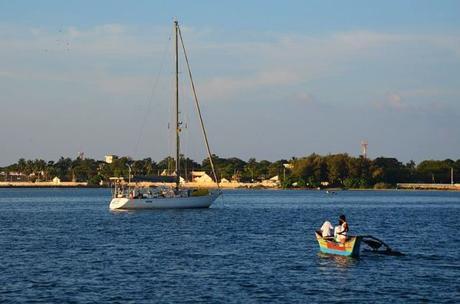
We approached Trincomalee with excitement and trepidation. This port is run by the Navy; it’s new to cruising boats after decades of civil war: officials don’t understand our needs, any more than cruisers understand theirs.
The first boats to arrive didn’t have the freedom they’re accustomed to at most cruising ports of call (such as not being allowed to anchor overnight and wait for clearance, but required to proceed to a specific location). There were concerns about the lack of transparency around fees, and ensuring that there is parity with the fees levied in Galle. Boats received services from the port (such as piloting, or dockage) which they didn’t realize they’d later be charged for. The port isn’t trying to duck on setting expectations, but they’re also not used to having line items questioned on a fee schedule. Cruisers aren’t used to having to wait 3-4 days to clear out (weather windows make this problematic). Those are just the highlights! Cruisers like to operate independently, and want things to be predictable and fair, and with early arrivals in particular, much of their experience was not predictable, and didn’t feel fair. We’ve had to get used to working more closely with the agent than is typical in other countries.

Navy provides final clearance papers to Rutea just before they depart
What we failed to appreciate before our arrival is the role Trincomalee played during the protracted civil war, and how that has influenced our reception. We toured a museum on the grounds of the Navy base, where much of the local action is documented- an eye opening visit. It’s sobering, and shocking. Beyond the tragedy of thousands upon thousands of human casualties, it is the harbor itself- as a major point of entry for supplies for the rebel Tigers- that was deeply affected. I lost count of how many ships were sunk, with methods like human torpedoes (basically, a person on an armament powered by a small outboard, driven at speed into the target), ‘limpet’ mines (stuck by divers onto the hulls of boats), and other suicide diver tactics. This explains the intense Navy scrutiny, and why the first boats arriving actually had divers checking their hulls for explosives. It’s just unheard of in our experience, but we can’t begin to imagine the war that is very recent memory here. It was disconcerting to have the very young looking Navy cadet with an AK47 on our aft deck while we cleared in. After the museum visit I could better understand where that caution comes from.
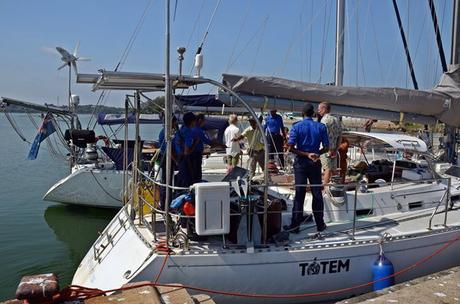
Navy personnel (and a big gun) on Totem during clearance
GAC (local agent) facilitated meetings, with their senior representative driving seven hours over from Colombo to meet with the Deputy Harbormaster in Trinco. Jamie and I were invited to participate to represent the cruising fleet. And we found at each turn, as miscommunication and misunderstanding was unraveled, that both agent and port were for us, not against us. They want to find a way to ensure Trinco becomes a more welcoming place for boats, and to enact the changes needed to improve the experience for cruisers. The Deputy Harbormaster said that the last time a fleet like ours came through was thirty years ago, so the lack of familiarity is pretty understandable.
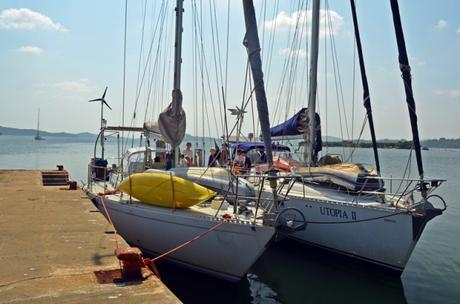
Totem and Utopia clearing in at the town pier
Some issues (like net clearance fees) were solved on the spot. A few were remedied within days (like putting processes in place to handle fuel, water, and garbage without incurring the fees levied merchant ships). Others need more time, because they involve legislative approval (as in domestic port-to-port clearance). It’s still not easy, but cruisers should be accustomed to being flexible with the uncertainties of traveling through foreign ports, and prepared to work a little for the benefits- or at least be good guests in the interim. Now, fees are on parity with Galle. The harbormaster understands we want relief from the technical Port requirements to work through our agent for things like a few cans of fuel or water, and we’re able to get them delivered to the dock now. And we see the changes in action with the progressively easier process for boats checking in and checking out. What took two days for the first arrivals is now being completed in just a couple of hours. We no longer need to leave our passports with police when we go to shore.
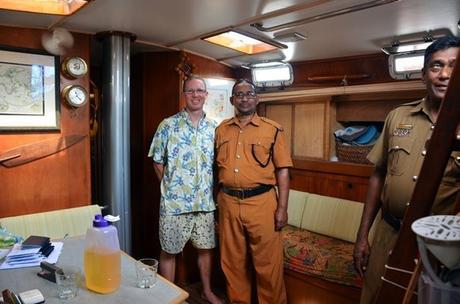
Mustapha is one of the security guards; we did a little show-n-tell on Totem
One boat decided they’d rather not follow the guidelines and ferry their own jerries on the beach, which was all observed by customs officials across the water. Jamie ended up in an unpleasant sandwich between an irate customs official’s wrath and the frustrated disappointment of the officials we had worked hard to establish norms for boats with. It’s blowing over, but that was all we needed to appreciate the delicacy of what’s being established.
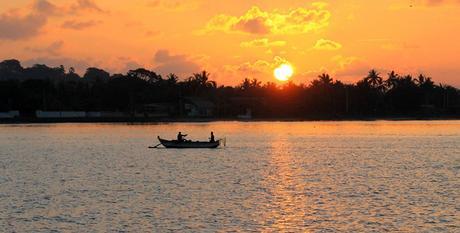
Bill from Solstice snapped this gorgeous sunrise over Trincomalee
Meanwhile, Trincomalee’s bay is the counterpoint everything I’ve heard about the mooring arrangement in Galle: we have a gorgeous harbor to swing at anchor, our boats are secure, there’s no 700 meter walk from the gate to the pontoons, and no cement dust corroding our gear from the nearby factory. But very much like Galle, there’s a delightful town to explore, the market is near bursting with beautiful produce, the culture is fascinating, the food is delicious, and the people we’ve met have been welcoming and friendly: it’s been well worth the effort to explore. It’s just plain that we’ve got to step in patiently, with respect for the people we’re working with, and the war atrocities that filter their handling of boats.
Good travelers know we love it when you read this on the Sailfeed website.

